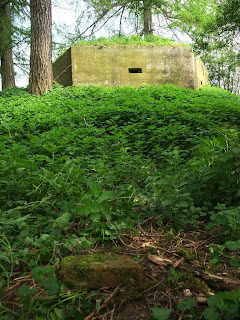Spent an enjoyable Saturday at Melford Hall, Long Melford. In the morning continued to assist in the survey of the defences in the Hall grounds, which formed part of the Eastern Command Line. In the afternoon became a National Trust Volunteer, helping dig a 1x1 mtr test pit on The Green as part of a TV series looking at the lives of ordinary people through the ages. The lives of the people of Long Melford are to feature in this and the series basically gets as many local people as possible to dig test pits, record and document what they find, under the supervision of professional archeologists. The National Trust property at Long Melford took part hence me becoming a NT volunteer for the afternoon.
Anyway back to the WW2 remains. I had already visited last Apr to look Pillbox ‘C5’ (the reference number given to it on the original plans) with NT surveyor Tom MacKinlay. C5 was a shell proof pillbox with a central AA well to drawing CRE 1113. During this visit we also located the position of the 2 pounder anti-tank gun (serial No F74 on the original plans).This time we wanted to try and find Pillbox ‘C6’ which I realized was on the property after my April visit. We found the approx location of the pillbox – now just a pile of rubble so obviously it had been demolished in the early 70’s to make way for the A134 bypass. Luckily the official records document this as " AA 3'6" " so we know it would have been the same design as C5.
We also found the location of anti-tank gun serial No F73. Its location was described in original documents as “Under lime tree in Melford Park” – and yes the lime tree still exists amongst the ancient pollarded oaks! A depression is nearby which maybe the in-filled remains of part of the position. With various contacts with the NT we hope to continue surveying the wider area next winter.
Another very productive visit to The National Archives. I hope now to add plenty of material to the website on invasion / War with Germany planning from the 1930’s onwards. I found this very informative as to describing how things got to where they were in Jun 1940 with regards to the defence against invasion. First page, on the war planning in the 1930’s, almost ready to be posted.
Finally thanks to the NT for the invite to see these defence works.
Image 1-3: C5 photographed in April
Image 4 & 5: The remains of C6
image 6: The Lime tree under which the 2 pounder anti-tank gun F73 was to be located
image 7: View from under the Lime tree- the trees in the background would not have been there in 1940 (or they would have been cleared to give the gun a line of fire) - the gun would have presumably covered the road bridge in Long Melford.







Comments
Post a Comment